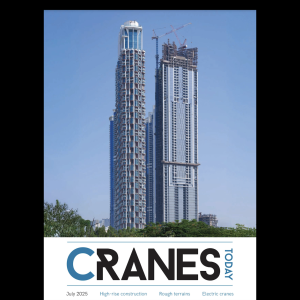Upon its planned completion in April 2022, ODE will accommodate the European headquarters and global training center of booking.com, 42 condominiums, space for restaurants and shops, and a double-level underground car park. The eleven-storey building, is being built by the Strabag subsidiary Ed. Zu¨blin.
Surrounded by water, building and rail tracks, there was only one position where a 500t mobile crane could be positioned to erect the first Wolff 700 B luffing jib crane at a distance of 28m. That installed the second Wolff 700 B which then assembled the three Wolff 355 B luffing jibs. A Wolff 7032.12 clear and a 5014 city had already been erected earlier in the year.
The buildings foundations also required customised anchors for the Wolff cranes. "The construction site's location requires a high degree of coordination in the daily workflow and the entire logistics. The crane concept plays a decisive role here," said Tobias Wallner, senior project construction manager at Zu¨blin.
The Wolff 700 B cranes were installed on 3.3m towers and the 355 B cranes on 2.9 m towers due to the prevalent strong winds on site, allowing them to work freestanding in stormy weather conditions.
Despite moderate tower heights between 47.2m and 54.2m the small jib radius and working range limitation means the luffing jib cranes can operate safely without getting in each other's way.
"Lower tower heights mean lower costs. Paired with the high lifting capacities of the WOLFF luffers, we were able to offer the customer a particularly cost-effective solution," explained Carsten Druske, head of rental Germany and branch manager Wolffkran Dortmund.
The site's proximity to railway tracks and entrance to an underground car park made it demanding for crane drivers and service technicians as these areas may not be slewed over. Construction work close to these areas has to be performed after-hours, when the system can be safely switched off, requiring several night shifts from the Wolffkran service team.
"The structure of the building is technically highly complex," said Wallner. "Heaviest steel components meet in-situ concrete and prefabricated construction combined with constantly changing geometries".
The WOLFF cranes can make the most of their 50t (700 B) and 28t (355 B) maximum capacities when lifting steel columns weighing up to 28t and precast concrete parts weighing up to 15t. Wolffkran's technical support team also calculated several special lifts for steel parts weighing up to 35t, which were performed as tandem lifts by the two 700 B luffers.
"The assignment in the Netherlands requires a separate risk assessment for each erection and dismantling as well as a schedule that has to be submitted before the start of construction. Besides, all cranes need to be equipped with additional safety features, such as warning signals and a mandatory hoist for the crane operator," said Druske.
Due to the special light conditions near the sea, all cranes were fitted with a camera system, enabling the crane operator to monitor the load and lifting process on a screen.






